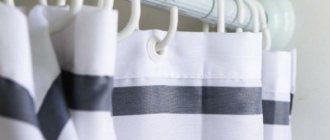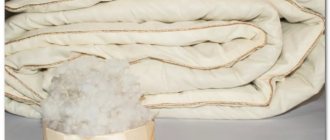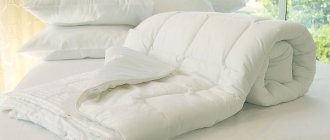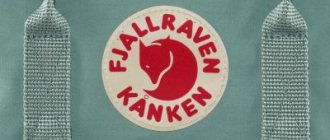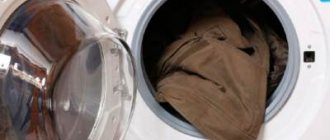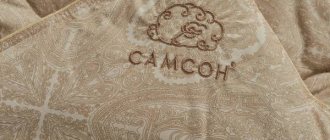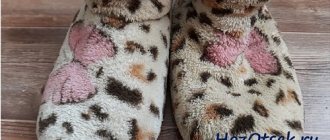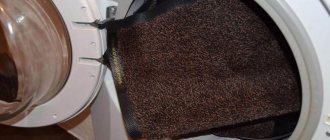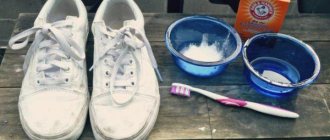Each section of a residential building requires certain attention related to the specific use. Increased humidity in the bathroom will inevitably lead to the formation of mold and mildew if it is not cleaned regularly. The formation of mold causes asthma, allergies, decreased immunity and many other unpleasant diseases in people, which is why it is especially important to keep the restroom clean.
A regular bathroom curtain can be both a protection against the spread of excess moisture during bathing procedures and a source of mold growth. Constant interaction and waterproof texture leads to certain difficulties during washing. Do not resort to powerful, chemical cleaning products. You can learn how to wash a bathroom curtain efficiently and safely here.
Is it possible to wash a bath curtain in a washing machine?
First make sure whether the curtain can be machine washed. If the manufacturer does not recommend it, it is better to limit yourself to hand washing.
Choose a washing mode based on the material of the curtain fabric.
- Polyethylene products cannot be machine washed. Even manual cleaning is likely to deform or tear them. If contamination occurs, it is better to remove it locally or replace the curtain with a new one.
- PVC curtains have a high density and can withstand washing on a delicate cycle.
- It is better to clean rubber products by hand. Machine washing will not tear them, but there is a risk of stretch marks.
- Textile materials can withstand the impact of the machine normally.
Exactly how it is permissible to wash a bathroom curtain is indicated on the tag attached to the product.
The feasibility of using an automatic machine should also influence the choice of cleaning method.
- To add freshness and get rid of odors, it is better to wash by hand.
- Removing traces of rust will require some effort before washing.
- An automatic machine will not cope with the complete removal of mold and mildew without the use of a special cleaning agent.
In other situations, you can wash the curtain in a machine.
Preventive measures
To ensure that the curtain always looks neat and well-groomed and does not pose a danger to your health, it is not enough just to wash it correctly.
Follow preventive measures that will “extend its life” and help avoid premature damage:
Ventilate the bathroom regularly. Especially after you've showered, turn on the hood or leave the room door open to circulate air and quickly reduce humidity.- After washing, rinse the curtain in a salty solution to create a protective layer that will prevent pathogenic microflora and various contaminants from appearing on it.
- After taking a shower, throw the curtain over the bath so that it does not come into contact with its surface and dries faster. It is also advisable to immediately wipe it dry with a towel.
- Use special protective equipment. Thus, a water-repellent spray will prevent the formation of limescale, and an antifungal spray will help prevent mold from forming on the material.
It is recommended to change your bathroom curtain every six months, even if you think it is still in good condition. Despite regular washing and compliance with all preventive measures, various bacteria and microbes accumulate in its structure, the proliferation of which will only negatively affect your health.
Partial cleaning and hand wash
Regardless of the material of the bath curtain, hand washing is preferable and, being more delicate, allows you to remove dirt locally.
Minor dirt and musty smells can be removed by simply rinsing in warm water and pre-soaking in a soap solution. Dissolve laundry soap shavings, washing powder or washing gel in warm water. After which the product is soaked for 30 minutes and rinsed in clean water.
When there is a need to wash the curtain to remove small stains that rinsing cannot remove, clean the curtain without removing it from its fastenings. This is also suitable for cleaning the shower stall.
- Wet the curtain on both sides using a shower.
- Soak a sponge in soapy water and apply it to the fabric on both sides.
- Wash away any soap marks.
For direct hand washing:
- Remove the curtain.
- Sprinkle the powder slightly diluted with water onto the contaminated areas. Using a sponge or brush, thoroughly treat the contaminated areas with powder.
- After grouting the stains, the product is soaked.
- If the manufacturer allows the use of bleach, you can add a few caps of bleach to the soaking water (allowed only for white curtains).
- After 30-40 minutes, rinse things in warm, clean water.
- There is no need to rub the curtain, this will lead to creases and ruin the item.
Whitening
Bleaching can only be used if there is no information on the label prohibiting the use of chlorine-containing products. A heavily soiled shower curtain should be soaked in a bowl of warm water, after dissolving 50 ml of bleach in it.
You can use both expensive products and the cheapest “Whiteness”. After 2-3 hours, the bath curtain is removed from the solution and washed in the usual way by hand or in a washing machine.
ARTICLE FOR YOU
How to properly wash children's clothes and children's bedding: in a washing machine and by hand
Whiteness as a cleaning agent
If the manufacturer's recommendations do not allow the use of chlorine bleaches, you can replace them with oxygen stain removers or use products for removing stains from baby clothes. They should be used not only for soaking, but also added to the drum of the washing machine before washing.
Machine washable
Washing a shower curtain in a washing machine is the most effective in removing surface dirt.
There are a number of recommendations on how to wash bathroom curtains:
- Use only the “delicate wash” or “hand wash” modes.
- The permissible temperature at which the curtain fabric is not damaged during washing should not exceed 40 degrees.
- We do not use the spin mode. The structure of the curtain fabric does not absorb excess moisture; spinning will not bring any benefit.
- Drying modes are prohibited. Drying, like spinning, is useless for curtains.
- Adding a little vinegar to the drum before washing will help soften the water.
- Before using a laundry detergent or gel, make sure it is suitable for the material you need to clean.
- Be sure to remove all fasteners before washing. Otherwise there is a risk of tissue damage. If it is impossible to remove the fastenings, use a special washing bag.
- To increase efficiency, it is better to wash the bathroom curtain together with terry towels. This will improve the quality of cleaning due to friction of the products against each other.
Tips from the professionals
To ensure that the washing goes without any unpleasant surprises, it is recommended that you familiarize yourself with useful tips from professionals. Knowing a few secrets and nuances, it is easy to speed up the cleaning process and reduce the risk of damage to the material to a minimum. We are talking about the following rules:
- do not wash the curtain as an ordinary thing, do not rub the fabric against the fabric (otherwise the fibers will deteriorate and become deformed);
- For cleaning the canvas, a foam sponge, an old toothbrush, or a soft cloth are suitable;
- It is forbidden to iron the shower film - it cannot withstand high temperatures;
- The curtain is dried in a vertical position naturally (without ultraviolet radiation or heating devices).
There is one more trick that will help keep your curtains clean longer. So, if you rinse the curtain in salted water for the final time, a film will form on the surface of the material, preventing dirt and dust from settling.
How to clean a bathroom curtain
When choosing a product to clean your bathroom curtain, pay attention to the nature of the dirt.
The most effective cleaning agents:
- Acidic foods. Concentrated citric acid or lemon juice will do.
- Washing powders and cleaning gels from reputable manufacturers (Vanish, Ariel, Tide).
- White items can be cleaned with baby laundry bleach.
- Table vinegar. It is recommended to add the product at each wash to soften the water.
- Stubborn stains can be softened by first covering them with baking soda and a little water.
Household chemicals
Products originally made for cleaning rooms with high humidity are better than others at helping to remove traces of mold and wash curtains in the bathroom. Most manufacturers indicate what type of material a particular product is suitable for.
Household chemicals used during cleaning must guarantee effectiveness in combating:
- With traces of rust.
- With the formation of mold.
- With the formation of fungus.
- Removing ingrained odor.
- Care and color restoration of the material.
If there is no information about the purpose of the product on the label, use an analogue from another manufacturer.
From what's at hand
The means at hand can help housewives wash the curtain by hand or in a machine, without using strong chemicals.
- Rust stains are removed by a mixture of ammonia (1/3) and hydrogen peroxide (2/3). Apply the mixture liberally to the stains, then wipe the surface with a sponge and rinse the item.
- Rust and deposits from cosmetics can be removed by soaking the curtain in warm water with the addition of a solution of table vinegar and soda. Mix a teaspoon of vinegar with 250 ml. water. Heat the mixture to 40-50 degrees and add half a spoon of table soda.
- Citric acid or lemon juice concentrate added during washing will help remove traces of limescale. It is necessary to add acid to water, rinse the curtain, then soak it in clean water.
- Laundry soap or dishwashing detergent will help remove common stains.
Possible contamination
Dirty bathroom curtains do not look very attractive, especially if they are light colors. Any stains, traces of mold and rust are immediately noticeable and, moreover, can cause the development of allergies. The easiest option is to throw away the damaged product. But the cost of high-quality curtains now is not small and it is better to try to bring the curtain to its original form. First of all, you need to know what types of contaminants can appear on a piece of bathroom furniture:
- yellowness and rust. Such defects usually appear at the bottom of the curtain due to constant contact with soapy water and foam;
- whitish stains. Appear on the curtain if the water in the tap flows with a high content of calcium and magnesium salts, due to which it becomes hard. After the drops dry, white marks remain on the product;
- fungus or mold. These living organisms reproduce where a warm and humid environment is present. The bathroom is just such a room. Fungi and traces of mold can often be seen on furniture, walls and curtains when there is no quality ventilation.
Fungus on a bathroom curtain - possible contamination
Of course, it is better to prevent such situations from occurring, but if this has already happened, you should know what control methods exist.
How to remove stains from oilcloth?
If it is necessary to remove a stain from an oilcloth, in particular an ink stain, then it is necessary to pour tooth powder onto the stained area and rub it very carefully on the oilcloth. This must be done very carefully, because you can erase the design on the oilcloth or the design on the oilcloth will fade.
Interesting materials:
What is the penalty rate for late rent? What percentage is paid on sick leave? What is the percentage of customs duty in Russia? What is the percentage of deposits in dollars in Sberbank? What kind of posting reflects the financial result from the sale of products? What is the minimum lifespan? What is the cost of living in Moscow? What is the cost of living in the Krasnodar region in 2022? What should your heart rate be when working out in the gym? What is the district coefficient in Yanao?

